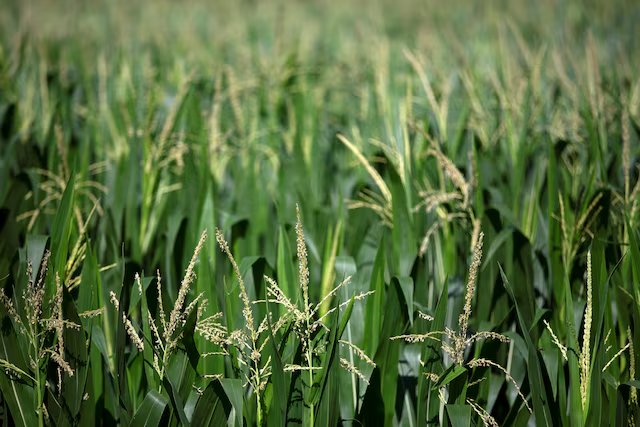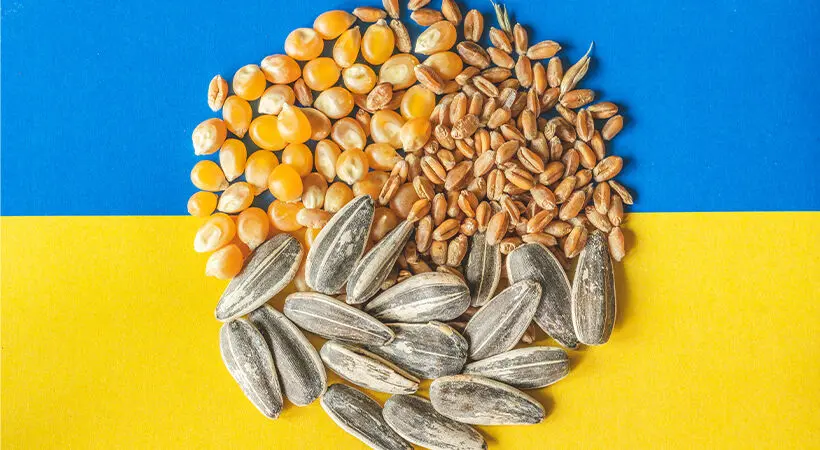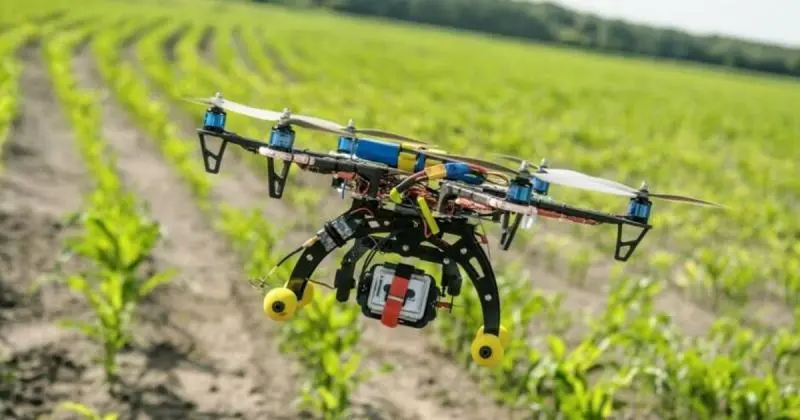Experts warn of falling US export advantage amid global competition
The United States, long regarded as a global agricultural leader, is facing a major shift as its farm trade balance moves deeper into deficit. According to a recent study by the University of Illinois Urbana-Champaign and Texas Tech University, US agricultural imports now surpass exports—a trend expected to worsen.
"For most of recent history, the U.S. was a net agricultural exporter. But in the last couple of years, that has reversed, and what used to be a persistent surplus has turned into a persistent and growing deficit, where we're importing much more than we export. Current projections estimate that the agricultural trade deficit will reach $49 billion by the end of 2025," said lead author William Ridley, associate professor in the Department of Agricultural and Consumer Economics, part of the College of Agricultural, Consumer and Environmental Sciences at U. of I.
While the US continues to be a top producer of crops like corn, soybeans, wheat, and cotton, exports are stagnating while imports—especially fruits, vegetables, and canola oil—continue to climb. The ongoing trade dispute with China remains a major factor behind this shift.
China’s retaliatory tariffs on key US exports such as soybeans, wheat, corn, and cotton have sharply reduced trade flows. Between 2017 and 2018 alone, soybean exports fell by 73%, wheat by 67%, and corn by 61%, amounting to a $14 billion overall loss.
Although the 2020 Phase One agreement briefly improved exports, trade quickly declined again. China has since turned to Brazil, Canada, and Argentina for supply, while investing heavily in its own crop production and biotechnology.
Meanwhile, competitors like Brazil are strengthening their market position through higher productivity and better export infrastructure. Analysts warn that without renewed market access or strategic investments, the US may continue to lose its edge in global agriculture.


CHICAGO, Oct 9 (Reuters) - U.S. data vital to global grain and soybean trading has gone dark during the federal government's shutdown, leaving commodity traders and farmers without crop production estimates, export sales data and market reports during the peak of the autumn harvest.
The data blackout comes at a particularly difficult time for farmers, who are grappling with low grain prices and uncertainty over damage to corn and soy fields from dry weather and crop diseases.
Previous shutdowns during President Donald Trump's first term were less disruptive because they happened after harvest season, analysts said.
Trump is now locked in a trade war with China that has kept the world's biggest soy importer from buying U.S. supplies. Traders have been watching closely for any hint of a deal, but the U.S. Department of Agriculture is not confirming export sales as usual now.
The disruption has left growers and traders without fresh government information on the progress of the harvest and the state of the crops. The industry relies on USDA reports to price and hedge commodities from corn and soy to cattle and hogs.
"The market is just flying blind here,” said Sherman Newlin, an Illinois farmer and analyst with Risk Management Commodities.
Among the halted releases are USDA's weekly export sales report and daily sales announcements, and its monthly World Agricultural Supply and Demand Estimates (WASDE), which was due on Thursday. The supply and demand report would have provided updates on U.S. corn and soybean output and global demand while farmers haul in large crops.
The Commodity Futures Trading Commission also suspended the release of weekly data that shows speculators' positions in the markets, which can influence crop prices.
The CFTC could not immediately be reached for comment, while the USDA blamed Democrats for data disruptions.
HTF MI just released the Global Agricultural Microbials Market Study, a comprehensive analysis of the market that spans more than 143+ pages and describes the product and industry scope as well as the market prognosis and status for 2025–2032. The marketization process is being accelerated by the market study’s segmentation by important regions. The market is currently expanding its reach.
𝐌𝐚𝐣𝐨𝐫 Giants 𝐢𝐧 Agricultural Microbials 𝐌𝐚𝐫𝐤𝐞𝐭
𝐚𝐫𝐞:
Bayer CropScience AG (Germany), BASF SE (Germany), Syngenta AG (Switzerland), UPL Limited (India), Novozymes A/S
(Denmark), Marrone Bio Innovations (USA), Certis Biologicals (USA), Koppert Biological Systems (Netherlands), Valent
BioSciences LLC (USA), Isagro S.p.A. (Italy)
HTF Market Intelligence projects that the global Agricultural Microbials market will expand at a CAGR of 14.9% from 2025 to 2032.
The Report Covers the Following Important Topics:
𝐁𝐲 𝐓𝐲𝐩𝐞:
Bacteria, Fungi, Viruses, Protozoa
𝐁𝐲 𝐀𝐩𝐩𝐥𝐢𝐜𝐚𝐭𝐢𝐨𝐧:
Cereals & Grains, Fruits & Vegetables, Oilseeds & Pulses, Turf & Ornamentals
The Agricultural Microbials Market refers to the sector dedicated to the development and application of microbial products used in agriculture to enhance crop yield, improve soil health, and promote sustainable farming practices. These products include...


In September 2025, Ukraine exported 2.84 million tons of agricultural products, which is 38% less than the same month last year (4.6 million tons).
This was reported by the Ukrainian Grain Association on Facebook.
Thus, wheat exports decreased by 21% and amounted to 1.83 million tons. In September, Ukraine exported 238 thousand tons of barley (+4%), rapeseed – 220 thousand tons (3.2 times less than in September 2024).
During this time, 61 thousand tons of corn went to foreign markets (8.6 times less than last year’s volume), soybeans – 78 thousand tons (three times less).
Sunflower oil exports decreased by 42% and amounted to 203 thousand tons.
177 thousand tons of pulses were exported (-24%).
According to preliminary estimates by the State Statistics Committee of Uzbekistan, in January-August 2025, the country significantly increased its dependence on external suppliers of sunflower oil, importing 163.4 thousand tons of the product from three key sources for a total of 163.1 million US dollars. This volume exceeded the indicators of the same period in 2024 by almost two times – the growth was 79.4 thousand tons, which indicates a rapid increase in demand for this product in the domestic market. Among the main suppliers, Kazakhstan dominates, from where 163.3 thousand tons came, while minor consignments were imported from Russia and Georgia – 111.6 tons and 0.1 tons, respectively, which emphasizes the regional orientation of trade.
In parallel with imports, Uzbekistan is demonstrating impressive growth rates in its own sunflower oil production: in eight months of 2025, large enterprises produced 83.5 thousand tons, which is twice as much as in the corresponding period last year. This jump is explained by the modernization of processing facilities and state support for the agricultural sector, including zero customs rates on raw material imports, which have been extended until 2026. Such steps not only stabilize supplies on the domestic market, but also create the prerequisites for future exports, transforming Uzbekistan from a net importer into a more self-sufficient player in the regional oil business.
At the same time, against the backdrop of successes with sunflower oil, the country is reducing imports of traditional cottonseed oil, which was dominant in previous decades. Experts predict a fundamental transformation of the consumption structure: new products, such as sunflower oil, will set records for demand and export growth, while classic oils for the region risk stagnation or even decline due to changing eating habits and economic realities.


Global Agricultural Drone Market reached USD 2,943.23 million in 2024 and is projected to witness lucrative growth by reaching up to USD 36,546.21 million by 2032. The market is expected to exhibit a CAGR of 37.01% during the forecast period (2025-2032).
The Agricultural Drone Market focuses on unmanned aerial vehicles (UAVs) used for crop monitoring, mapping, and precision farming. These drones help farmers optimize irrigation, pest control, and yield estimation through high-resolution imaging and data analytics. Rising adoption of smart agriculture and AI integration drives market growth. Governments and agritech companies are promoting drone-based solutions for sustainable farming practices. Innovations in LiDAR, multispectral imaging, and real-time monitoring enhance productivity. The market is rapidly expanding as digital transformation reshapes the agricultural sector.
Last week, a slight increase in quotations and prices for vegetable oils was recorded, caused by increased demand from Chinese importers on the eve of the holiday week.
November palm oil futures on the Bursa Malaysia exchange rose 2.7% during the week to 4,470 ringgit/t or $1,062/t, despite a significant reduction in September supplies to India.
India reduced palm oil imports by 15.9% in September to 833,000 tonnes, a four-month low, as refiners preferred cheaper soybean oil, according to five dealers.
According to Oil World, in June-August 2025, global palm oil exports reached 14.8 million tons — a record level for this period, which is 1.7 million tons more than last year.
- Indonesia increased exports to 8.9 million tons (versus 6.8 million tons a year ago),
- while Malaysia reduced supplies to 3.9 million tons (from 4.4 million tons)
Since the beginning of the 2024/25 season (September–August), global palm oil exports have amounted to 43.44 million tons (last year — 42.6 million tons), of which:
- Indonesia — 26.69 million tons (last year 25.37 million tons),
- Malaysia — 15.74 million tons (last year 16.23 million tons),
- Thailand — 1 million tons (at the same level as last year)


Ukraine has harvested 5.5 million tons of sunseed compared to 8 million tons last year. Factories are currently supplied with raw materials until the end of October – the first decade of November.
This is reported by analysts at Spike Brokers.
Agricultural producers sold about 1.5 million tons of sunflower sseeds, which is not enough given the possible change in sales plans by producers after the approval of the mechanism for exempting them from customs duties on the export of rapeseed and soybeans. Producers are focused on fulfilling previously concluded contracts, while contracting new volumes has slowed down due to a decrease in purchase prices from processors, who are thus trying to improve the marginality of processing.
World prices for sunflower oil have increased by $40 over the past week, while in Ukraine processors have reduced purchase prices by $6-10 including VAT. This gap creates an imbalance between the domestic and foreign markets, which makes Ukrainian sunflower look undervalued by $20-30.
The spot price index for sunseed with delivery within 30 days decreased by $6 incl. VAT to $680 incl. VAT. This is the price for the basic quality 8/3/48, adjusted for the cost of transportation from the plant to the SRT Odesa base.